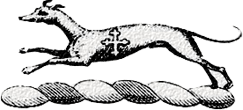Post by Daniel Silk on Aug 13, 2009 21:21:18 GMT
www.archive.org/stream/calendarsofalhal00rogerich/calendarsofalhal00rogerich_djvu.txt
SCULL OF S. THOMAS OF CANTERBURY. 201
pended from the ceiling twice a year, and
perhaps on some other special occasions.
It would be an almost endless task to attempt
describing the host of curious relics and bene-
factions which belonged to these brethren
prior to the dissolution of religious houses.
Among the former, we may mention that
they boasted of being in possession, not only
of the candlestick* but of the scull of the
canonized martyr-prelate, S. Thomas of Can-
terbury. The two entries in the Church
Book referring to the candlestick and scull
of Archbishop Becket, who was murdered
A. D. 1170, are both crossed out, but
manifestly, from the colour of the ink, by
a comparatively late pen. The scull would
have been considered an invaluable relic-
bearing, as it necessarily would, the marks
* The candlestick, which was of brass, was presented to the
church by Sir William Selke, who was a brother of the Calendars,
and Vicar of All Saints in 1280.
202 SCULL OF S. THOMAS OF CANTERBUBY.
of those blows and cuts which disimprisoned
his saint-like soul. We cannot but be
surprised that so small a fraternity as that of
the Calendars should have possessed it. We
may indeed very reasonably question whether
it ever did. The Archbishop was buried in
the crypt of Canterbury Cathedral ; two years
later he was canonised ; in 1221 his body was
disinterred, and removed to a rich shrine at
the eastern end of that church, in the presence
of King Henry III. and a great concourse of
the nobility and others: many miracles were
said to have been wrought at his tomb. A
clever thief must he have been who under
such circumstances could have purloined the
skull, or even a part of it. The attribute of
S. Thomas of Canterbury, whether in painting,
stained glass, or tapestry, is " kneeling, a
" man behind with a sword, the middle edge
" of which is fixed in Becket's scull :" the
original skull itself would be considered
beyond all price valuable.
SCULL OF S. THOMAS OF CANTERBURY. 201
pended from the ceiling twice a year, and
perhaps on some other special occasions.
It would be an almost endless task to attempt
describing the host of curious relics and bene-
factions which belonged to these brethren
prior to the dissolution of religious houses.
Among the former, we may mention that
they boasted of being in possession, not only
of the candlestick* but of the scull of the
canonized martyr-prelate, S. Thomas of Can-
terbury. The two entries in the Church
Book referring to the candlestick and scull
of Archbishop Becket, who was murdered
A. D. 1170, are both crossed out, but
manifestly, from the colour of the ink, by
a comparatively late pen. The scull would
have been considered an invaluable relic-
bearing, as it necessarily would, the marks
* The candlestick, which was of brass, was presented to the
church by Sir William Selke, who was a brother of the Calendars,
and Vicar of All Saints in 1280.
202 SCULL OF S. THOMAS OF CANTERBUBY.
of those blows and cuts which disimprisoned
his saint-like soul. We cannot but be
surprised that so small a fraternity as that of
the Calendars should have possessed it. We
may indeed very reasonably question whether
it ever did. The Archbishop was buried in
the crypt of Canterbury Cathedral ; two years
later he was canonised ; in 1221 his body was
disinterred, and removed to a rich shrine at
the eastern end of that church, in the presence
of King Henry III. and a great concourse of
the nobility and others: many miracles were
said to have been wrought at his tomb. A
clever thief must he have been who under
such circumstances could have purloined the
skull, or even a part of it. The attribute of
S. Thomas of Canterbury, whether in painting,
stained glass, or tapestry, is " kneeling, a
" man behind with a sword, the middle edge
" of which is fixed in Becket's scull :" the
original skull itself would be considered
beyond all price valuable.

